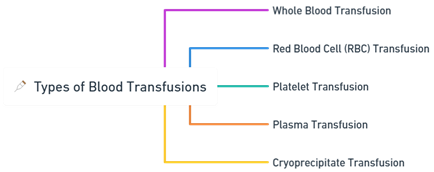- A blood transfusion is a medical procedure where blood or its components are transferred from a donor to a recipient’s circulatory system.
- This is crucial in treating various conditions, such as blood loss, anemia, clotting disorders, and diseases affecting blood cell production.
Types of Blood Transfusions
Whole Blood Transfusion
- Transfers all blood components but is less common today as component-specific transfusions are safer and more efficient.
Red Blood Cell (RBC) Transfusion
- Concentrated red blood cells are used to address anemia, significant blood loss, or hemoglobinopathies.
Platelet Transfusion
- Essential for blood clotting, used in treating low platelet counts due to conditions like leukemia or chemotherapy.
Plasma Transfusion
- The liquid part of the blood containing essential proteins and clotting factors, used in treating clotting disorders or restoring blood volume.
Cryoprecipitate Transfusion
- A concentrated plasma product containing specific clotting factors, used in treating bleeding disorders or clotting factor deficiencies.
Compatibility and Safety
- Compatibility Testing: Involves blood typing and crossmatch tests to ensure donor blood matches the recipient’s, reducing the risk of adverse reactions.
- Transfusion Reactions: Can range from mild (fever, hives) to severe (anaphylaxis, TRALI). Meticulous testing and protocols minimize these risks.
Significance of Blood Transfusion
Replacement of Blood Loss
- Essential in surgeries, trauma, or severe injury to maintain blood volume and prevent shock or organ failure.
Treatment of Anemia
- Transfusions of RBCs treat anemia caused by chronic disease, blood loss, or bone marrow failure.
Hemostatic Support
- Platelet or plasma transfusions help control or prevent bleeding in patients with clotting disorders.
Immune System Support
- Immunoglobulin or white blood cell transfusions support patients with immune deficiencies or infections.
Correction of Blood Component Imbalances
- Transfusions correct imbalances in blood components like plasma or electrolytes in conditions like liver disease or severe burns.
Exchange Transfusion
- Involves removing and replacing a patient’s blood with donor blood, used in cases like severe hemolytic disease of the newborn or poisoning.
Click Here to Watch the Best Pharma Videos


